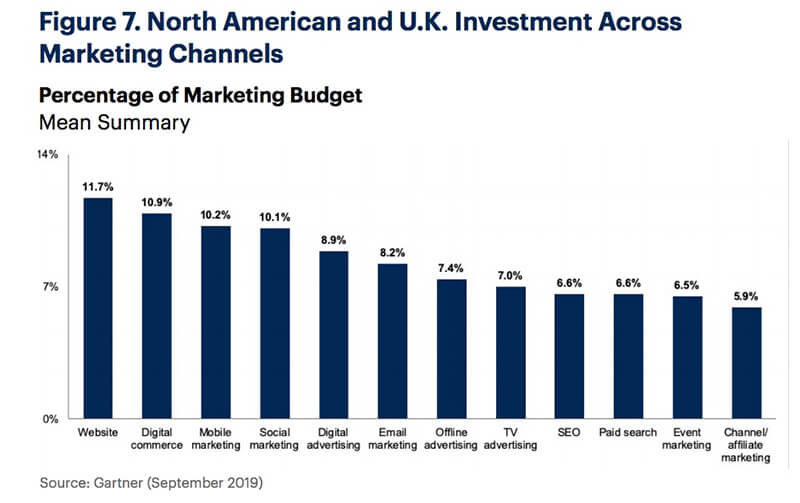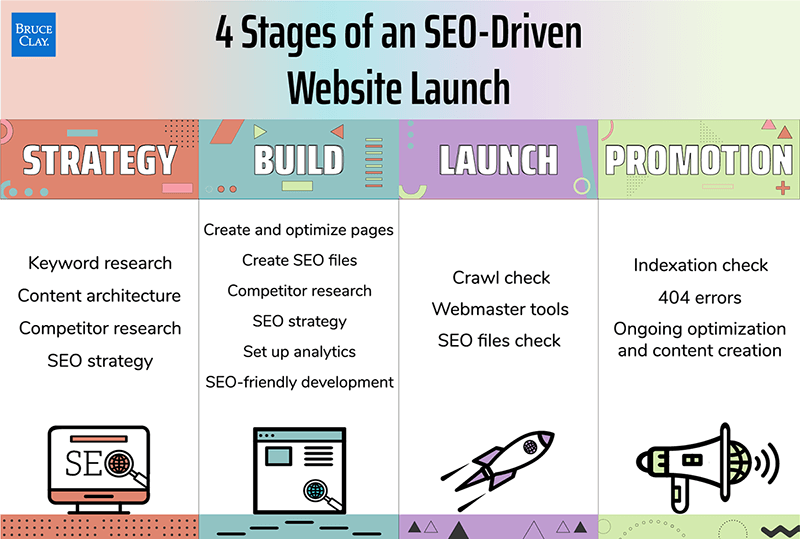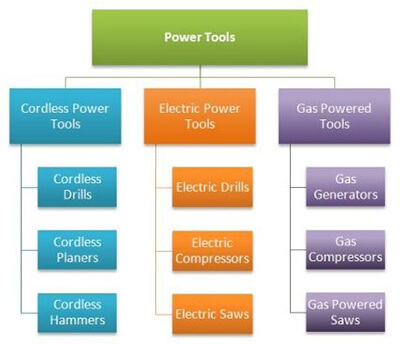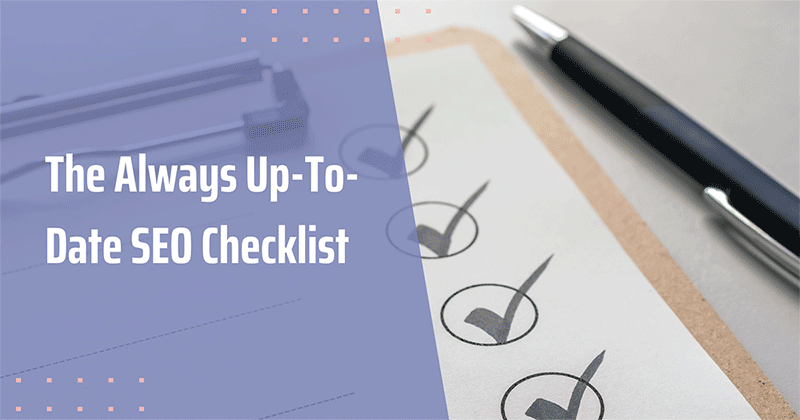The 4 Stages of an SEO-Driven Website Launch

Building SEO into a website from the ground up — even before you launch — sets your website up for success right out of the gate. And yet, SEO is often an afterthought, even for large companies with big budgets. “We launch next week so let’s check the SEO” is certain death.
This Gartner data on percentage of marketing budget invested per channel baffles me. Below, you can see that most of the budget goes to things like the website, digital commerce and mobile marketing. But all the way down the line is SEO — as if it has nothing to do with any of those top priorities.

So, let’s look closer at how you can incorporate SEO throughout the whole design process and launch your website with higher success.
The 4 Stages of a Website Launch with SEO
When launching a website, there are four stages to consider, each with its own tasks and milestones. In each of the following phases, the person in charge of SEO should cooperate with other teams (design, development, UX, strategy, and others):

Stage 1: Strategy and Planning
A web launch’s strategy and planning stage is fundamental for its success. This is when you lay the foundation.
In terms of SEO, the most important steps in this stage are keyword research and content architecture. Before the web design team gets to work on concepts, the person in charge of SEO needs to provide the keyword and architecture strategy. That’s because this SEO guidance will help shape how designers and developers build the site.
Keyword Research
Keyword research is one of the most important steps in an SEO project. As a website publisher, you need to understand who your target audience is and what search queries they use to find your products and services. Then, this information serves as the foundation for your website in terms of how you architect it and the content you create for it. More on that next.
Read more:
Content Architecture
Once keyword research is done, the person in charge of SEO can begin to theme the website. This involves mapping out the website structure based on the top keywords that are important to a website. A site map mockup will show what pages to create, including the top navigation and the subnavigation.

This is what we refer to here at Bruce Clay Inc. as SEO siloing. SEO siloing can make or break a website’s perceived expertise by Google, its rankings, and even the user experience.
Read more:
- SEO Siloing: What Why How
- 5 Times When SEO Siloing Can Make or Break Your Search Engine Rankings
- SEO Siloing: How to Build a Website Silo Architecture
Stage 2: Develop and Build
The build stage is usually the longest stage of a website project. During this stage, the designers and developers build the site. But from an SEO perspective, there are two key tasks: creating content and working with developers on the technical side.
Content Creation
Each silo or navigational category needs to be filled with quality content. That means creating quality content that is built with an understanding of Google’s quality standards. It also means creating webpages driven by real-time SEO data based on the top-ranked competitors for those target keywords.
You’ll want to get this data before you create the pages. That way the content meets or exceeds what your competitors are doing on the first page of the search results.

And anyone can get this data through the right tools, one of which is our WordPress SEO plugin. You can read more about that below.
Read more:
- WordPress SEO Plugins: Why Real-Time and Customized Data Matters
- Want Customized SEO Advice per Keyword? There’s a Plugin for That!
- How a WordPress SEO Plugin Can Help You Optimize Your Content with Keywords
- E-E-A-T and SEO: You Can’t Have One Without the Other
Technical Strategy
SEO is not a core strength of many website designers and developers. So they often inadvertently build a site that hinders the search engines from doing their job: crawling, indexing and understanding a website and its content. For example, Flash and JavaScript implementations sometimes create obstacles for search engines.
But that’s just one example of what can go wrong and what needs to be optimized during the build for SEO. As Google tunes its algorithms to reward sites that provide a good user experience, performance issues also become concerns for SEO.
Read more:
Stage 3: Prelaunch and Launch
Before you launch the site and during launch, the person in charge of SEO needs to be involved in overseeing some critical things. This stage should be fairly smooth if the previous stages were conducted well. But you still need to ensure everything is in order.
Prelaunch
Crawlability and Accessibility
The website should be crawled using an SEO tool to see if there are any errors. You can use a site crawler like Screaming Frog or our tools in the SEOToolSet® for this. As part of this task, you’ll want to see that the number of pages that are created and crawled is the same. If there is a difference, the next step is to find out what is causing the issue and fix it.
Google Analytics and Google Search Console
It’s important to have basic SEO analytics set up before launch. It will help you watch the website and get access to valuable data from the moment the site is published. Without this data, it is impossible to improve website performance through data-driven decisions.
Read more: 7 Google SEO Tools Every Website Publisher Should Use
Technical Items
At this stage, things like the XML sitemap, HTML sitemap and robots.txt file should be properly set up. But you’ll want to test them. In some cases, web developers or others can forget to remove the Disallow: / directive from the robots.txt file (used to keep pages from being indexed during the build and testing phases).
Read more:
- What Is an XML Sitemap and How Do I Make One?
- SEO Guide: How to Create a Sitemap
- SEO Guide: How to Submit a Website to Search Engines
Launch
SEO to-dos in the launch stage involve a lot of monitoring. In particular, you’re watching for errors and indexation.
Errors
Using SEO tools including Google Search Console, check and fix any technical errors that might pop up. Common issues include 404 errors that stop users from accessing a webpage or other problems.
Indexation
Depending on the size of the website, it might take a few days or weeks for search engines to index a site fully. If it seems that there are some areas that are not indexed, investigate and fix the issues. Is there adequate internal linking to ensure maximum indexation?
Stage 4: Post Launch
The work does not stop once the website is successfully launched. SEO is an ongoing process — there are always things to test and optimize.
Content
Add new content to the site regularly. Build more supporting content for your silo structure and interlink pages appropriately.
Also, update the existing content to keep it fresh.
Links
Maintain your link profile. You want to ensure you have high-quality, relevant links over other types.
Read more:
- SEO Is Done When Google Stops Changing Things and All Your Competition Dies
- The 13-Step Web Content Audit to Boost Visibility in the Search Results
- 50 Ways to Get Quality, “White Hat” Backlinks
- What Is a Whole-SERP Strategy?
Performance
Once the site goes live, check the performance of the homepage and other important pages you want to rank regularly. Tools like Google’s PageSpeed Insights or Lighthouse help with this. You can earn a ranking boost for providing a measurably good page experience.
Read more:
- How Fast Should My Webpage Be and Why Should I Care?
- What CMOs Need to Know about Google’s Page Experience Update
Takeaways
SEO is critical to building a website that is not only functional, but also able to compete in the search results. If you’re part of a website launch team, remember these principles:
- Involve SEO in the web launch from the beginning.
- Ensure that SEO strategy and planning are a part of each step.
- Make sure the website is built in an SEO-friendly way.
- Continue with a strategic SEO plan after launch.
We’ve helped many clients through web migrations and new site launches. If you’d like guidance to ensure your strategy succeeds, contact us today for a free quote and consultation.
FAQ: How can I effectively incorporate SEO strategies into every stage of building and launching a website?
The journey of building and launching a website encompasses several pivotal stages that can significantly enhance a site’s visibility and reach when approached with SEO in mind. By seamlessly blending search engine optimization techniques into each phase, you can lay a strong foundation for your website’s online success.
Planning and Research
Before diving into website development, thorough planning and research are essential. Identify relevant keywords and key phrases that resonate with your target audience. Conduct competitive analysis to gain insights into what’s working in your industry. This groundwork will set the stage for strategic content creation and optimization.
Design and UX
Prioritize user experience (UX), and make sure your website is mobile-friendly and responsive. Site speed, intuitive navigation, and engaging visuals contribute to user satisfaction and search engine rankings. Integrate keywords naturally into your design elements and metadata.
Content Creation and Optimization
Compelling, relevant, and well-optimized content is the backbone of SEO. Create valuable content that addresses user intent and incorporates your identified keywords. Regularly update your blog with fresh content to showcase your expertise and keep users returning. Use descriptive titles, headers, and meta descriptions to enhance search visibility.
Technical SEO Implementation
Underneath the surface, technical SEO plays a crucial role. Optimize your website’s structure for search engine crawlers by creating a logical URL structure, using XML sitemaps, and implementing schema markup. Ensure your website is secure with HTTPS, fix broken links, and optimize images for faster loading times.
Pre-launch and Post-launch Optimization
Before launching, conduct a comprehensive SEO audit to address any issues. Check for duplicate content, ensure proper 301 redirects, and verify metadata accuracy. After launching, monitor your website’s performance using analytics tools. Track keyword rankings, organic traffic, and user engagement to make data-driven refinements.
Weaving SEO strategies throughout every stage of website development is essential for achieving long-term online success. A holistic approach will enable you to develop a website that attracts both search engines and users alike. SEO is an ongoing process; therefore, keeping up with industry trends and algorithm changes is vital for keeping your site competitively priced.
Step-by-Step Procedure: Incorporating SEO Strategies in Website Development
- Conduct thorough keyword research to identify relevant terms and phrases.
- Analyze competitors’ websites to gain insights into effective strategies.
- Prioritize mobile-friendly and responsive design for optimal user experience.
- Integrate keywords naturally into design elements and metadata.
- Develop valuable, keyword-rich content that addresses user intent.
- Maintain a consistent content creation schedule to showcase expertise.
- Create descriptive titles, headers, and meta descriptions for each page.
- Optimize website structure with logical URLs and XML sitemaps.
- Implement schema markup to enhance search engine understanding.
- Ensure website security with HTTPS and fix broken links.
- Optimize images for faster loading times and better user experience.
- Conduct a pre-launch SEO audit to address any optimization issues.
- Implement 301 redirects and ensure accurate metadata before launch.
- Monitor keyword rankings, organic traffic, and user engagement post-launch.
- Utilize analytics tools to gather data for informed decision-making.
- Regularly update content to reflect industry changes and user needs.
- Stay informed about SEO trends and algorithm updates.
- Continuously refine and improve the website based on performance data.
- Adapt strategies to evolving search engine guidelines.
- Engage in ongoing learning to stay ahead in the dynamic field of SEO.

8 Replies to “The 4 Stages of an SEO-Driven Website Launch”
All very important aspects to cover off, competition analysis is certainly a factor that is often overlooked but very important.
Making a website SEO-friendly means that Google and other search engines can crawl each page on the website efficiently, interpret the content effectively, and index it in their database. Once indexed, they can then serve the most relevant and valuable web pages to their users based on the topics they search for.
LEAVE A REPLY









